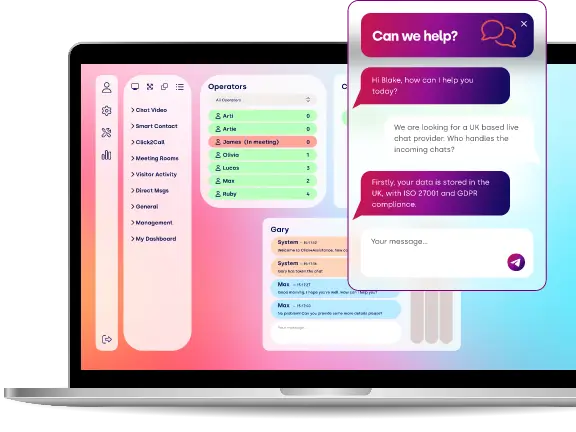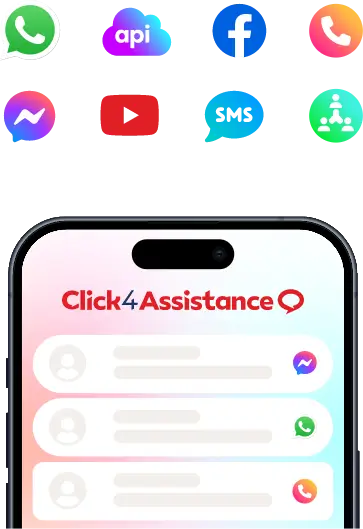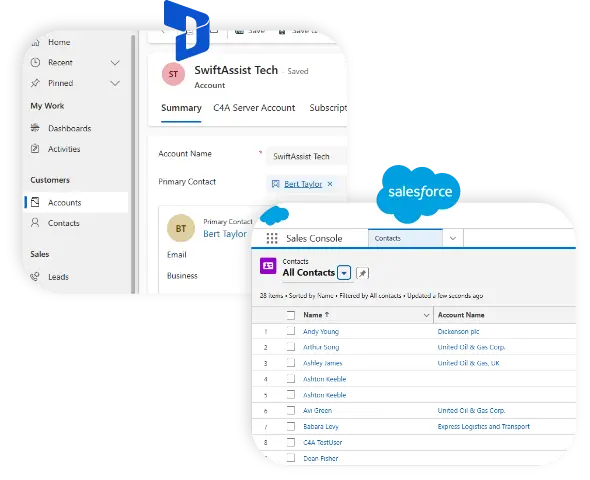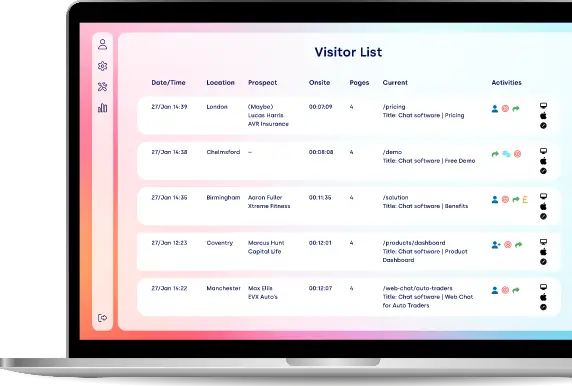Conversational Chatbots: The Future of Customer Experience
Customer expectations are higher than ever. People want instant responses, personalised experiences, and convenient solutions. To meet this demand, more businesses are turning to conversational chatbots.

A conversational chatbot uses artificial intelligence (AI) and natural language processing (NLP) to hold meaningful, human-like conversations. It listens, understands, and responds in real time, creating experiences that feel effortless for customers while delivering measurable value for businesses.
Companies that want to create faster, smarter, and more personalised online experiences are increasingly turning to AI-powered customer engagement solutions. With the right AI customer service software, businesses can provide instant support, automate repetitive tasks, and build meaningful connections that strengthen customer relationships. In fact, Forbes reports that AI chatbots are playing a key role in enabling brands to respond proactively to customer touchpoints.
This guide explores what a conversational chatbot is, why it matters, and the top 10 ways businesses can use a conversational chatbot on their website to improve engagement, conversions, and customer satisfaction.
What Is a Conversational Chatbot?
A conversational chatbot is an AI-powered virtual assistant that communicates with users in natural language. It goes beyond predefined scripts to understand intent and provide contextual answers.
The main technologies powering conversational chatbots include:
- Natural Language Processing (NLP): Natural Language Processing is the backbone of any conversational chatbot. It enables the bot to interpret human language and understand the meaning behind it. With NLP, a chatbot can recognise keywords, detect intent, and even pick up on subtle variations in phrasing. For example, whether a customer types “Where’s my order?” or “Track delivery status,” the chatbot understands both requests mean the same thing and provides the right response.
- Machine Learning (ML): Machine Learning allows conversational chatbots to get smarter over time. By analysing past conversations and outcomes, ML helps the chatbot refine its responses and better predict what users are asking. For instance, if customers often ask about “shipping times” in different ways, ML helps the chatbot recognise all those variations and respond accurately. This continuous improvement assists NLP, making the chatbot more reliable, efficient, and user-friendly.
- Dialog Management: Dialog Management controls the flow of the conversation to make it feel natural rather than robotic. Instead of offering rigid, one-line answers, the conversational chatbot can manage back-and-forth exchanges, ask follow-up questions, and keep users on track toward their goal. For example, if a customer wants to book an appointment, dialog management ensures the chatbot asks for the right details in the correct order, such as date, time, and service type.
- Integrations: A conversational chatbot becomes truly powerful when it integrates with business systems like Customer Relationship Management (CRM) software, e-commerce platforms, or scheduling tools. This allows the chatbot to do more than just answer questions. It can retrieve account information, process orders and book appointments in real time. For example, a customer asking, “Can I reschedule my delivery?” can have their request completed directly through the chatbot without human intervention. Together, these technologies transform a conversational chatbot from a basic Q&A tool into a fully functional digital assistant capable of handling complex interactions and delivering seamless customer experiences.
Why Businesses Need a Conversational Chatbot
Customers are no longer willing to wait for responses. A conversational chatbot helps businesses provide immediate value:
- Instant Availability Across Time Zones
Unlike human agents, chatbots are available 24 hours a day, seven days a week. This is particularly important for organisations serving an international audience, where customers or students may be in different time zones or need support outside standard office hours.
Example: A UK university offering courses to international students can provide immediate guidance on course options, application requirements, and deadlines, no matter where the student is located. Whether a student in India, Brazil, or China accesses the website at 2 am local time, the conversational chatbot can answer queries, provide links to course pages, or guide them through the application process.
Instant availability helps universities capture potential applicants who might otherwise delay or abandon their application due to a lack of timely support. It also builds trust by offering a reliable, always-on source of information for students making important decisions about their education.
According to a survey reported in Customer Experience Dive, customer experience leaders expect self-service and live chat to overtake phone and email as primary support channels by 2027.
- Reduced Support Costs by Automating FAQs
Many businesses spend a significant portion of their support budget handling repetitive and simple queries. Chatbots can automate these FAQs, such as:
- Tracking deliveries
- Explaining return policies
- Providing basic product information
Example: A small UK online retailer implemented a conversational chatbot to answer repetitive questions, reducing support tickets by over 40%. This not only saved staff time but also allowed human agents to focus on more complex queries that required empathy or problem-solving.
Automating FAQs reduces operational costs, increases efficiency, and ensures that customers receive instant, accurate information without waiting in a queue.
- Higher Engagement Through Personalised Conversations
A conversational chatbot can analyse user behaviour, purchase history, and preferences to create tailored interactions. This personalisation makes customers feel valued and understood, increasing engagement and trust.
Example: A visitor browsing winter coats on a UK fashion retailer’s website could be presented with suggestions for complementary accessories, like scarves or gloves, along with relevant promotions. By making recommendations that match the customer’s interests, the chatbot encourages further interaction and increases the likelihood of a purchase.
Personalised conversations also allow businesses to collect insights on customer preferences, which can inform marketing campaigns, product development, and loyalty programmes.
- Scalability That Allows Thousands of Chats Simultaneously
Human teams have limitations—they can only handle a finite number of customer interactions at once. Conversational chatbots can manage thousands of simultaneous conversations without delays.
Example: During peak periods such as Black Friday or Boxing Day sales, a UK retailer can ensure that every visitor receives instant support and guidance without overloading human agents.
Scalability also allows businesses to grow without proportionally increasing support staff, ensuring that customer service remains consistent even as traffic increases.
- Data-Driven Insights About Customer Needs and Behaviour
Every interaction a conversational chatbot has generates valuable data. Businesses can analyse this information to understand customer preferences, identify trends, and improve products or services.
Example: A chatbot frequently receiving questions about delivery times may indicate that shipping information on the website needs to be clearer. Similarly, if many users abandon a checkout process, the data can highlight friction points to improve the user experience.
By using this data strategically, businesses can optimise marketing, sales, and customer support strategies, creating a more responsive and customer-centric operation.
In summary, a conversational chatbot allows businesses to provide immediate support, save costs, increase engagement, scale effortlessly, and gain actionable insights. For modern organisations, implementing a conversational chatbot is no longer optional, it is a key differentiator in a competitive marketplace, helping brands delight customers, improve efficiency, and drive growth.
For modern businesses, a conversational chatbot isn’t just a convenience; it’s a competitive advantage.
Manage Customer Service with Your Own AI Agent
Meet Arti, your fully trainable AI Agent. Use your website and documents to teach Arti how to deliver fast, accurate, and personalised customer support.

10 Ways Businesses Use Conversational Chatbots on Their Websites
The beauty of a conversational chatbot is its versatility. From customer support to marketing automation, businesses can use chatbots in a variety of ways. Here are ten impactful use cases.
- Provide 24/7 Customer Support
Customers expect answers at any time of day, not just during business hours. A conversational chatbot ensures your website is always open for support, handling common queries like delivery updates, return policies, troubleshooting steps, or pricing information. By instantly resolving these questions, your business reduces wait times and boosts customer satisfaction. It also saves your human support advisors from answering repetitive requests.
- Generate and Qualify Leads
Visitors often fail to engage with static forms. Instead, a conversational chatbot can start a dialogue: “Hi, are you looking for a product demo or pricing information today?” Based on the user’s answers, the bot can capture contact details, assess readiness to buy, and route hot leads to the sales team. This conversational approach feels less intrusive than filling out a form and often results in higher conversion rates.
- Recommend Products and Services
Think of a conversational chatbot as a digital sales assistant. When a visitor browses your website, the chatbot can suggest relevant products or services based on browsing history, past purchases, or customer preferences. For example, if someone is looking at trainers, the chatbot might recommend matching socks or a fitness tracker. Personalised recommendations not only increase sales but also make customers feel understood and valued.
- Book Appointments and Demos
Conversational chatbots can simplify appointment booking by asking customers when they’re available, syncing calendars, and confirming bookings. This eliminates the multiple emails or phone calls that usually slow down the process and add frustration, as well as increasing possibility of customers dropping out throughout the process. Whether it’s arranging a spa treatment, scheduling a medical consultation, or booking a product demo, the chatbot makes it effortless for both the customer and the business.
- Offer Real-Time Order Tracking
“Where’s my order?” Instead of overwhelming support teams with these requests, a conversational chatbot can integrate with order management systems and instantly provide shipping updates, delivery estimates, and tracking links. Customers appreciate the quick response, and businesses save time and money by reducing repetitive enquiries. It’s a win-win scenario, especially for e-commerce websites that deal with large volumes of orders daily.
- Deliver Interactive FAQs
Scrolling through a static FAQ page can feel overwhelming for users. A conversational chatbot offers a more engaging solution by allowing visitors to type questions in their own words and receive instant answers. For example, a customer might ask, “How do I reset my password?” and the chatbot can walk them through the process step by step. This makes the FAQ experience interactive, personalised, and far more effective in resolving issues quickly.
- Onboard and Educate New Customers
First impressions matter. A conversational chatbot can serve as a digital guide for new users, helping them register, log in, or explore product features. For technical businesses, the chatbot can provide interactive tutorials or explain key tools. By reducing friction during onboarding, businesses increase adoption rates and customer satisfaction. In many cases, this proactive guidance also reduces churn by making customers feel supported from day one.
- Collect Feedback and Present Surveys
Feedback is critical for business growth, but customers are less likely to complete lengthy surveys. Conversational chatbots make the process engaging by asking quick, simple questions in real time. For example, after a purchase, the chatbot might ask, “How would you rate your shopping experience today?” This casual, conversational style feels less like a survey and more like a chat, which boosts response rates. The data collected can help businesses identify strengths and areas for improvement.
- Transfer to a Human Agent Seamlessly
Automation is powerful, but it can’t solve every problem. A well-designed conversational chatbot knows its limits and smoothly escalates the conversation to a live advisor when necessary. Importantly, it also passes the full chat history so the customer doesn’t need to repeat themselves. This hybrid model ensures that customers always get the right level of support; automated when possible, human when necessary. It’s the perfect balance of efficiency and empathy.
- Collect Information Before Handoff
Before escalating an issue, the chatbot can collect essential details such as the customer’s name, contact information, account number, order ID, and a brief description of the problem. This pre-conversation data collection ensures that the human advisor has all the necessary context to resolve the issue quickly and accurately. For example, if a customer is reporting a billing issue, the conversational chatbot can ask for the relevant account details and the nature of the problem before transferring the chat. When the human agent takes over, they can immediately address the concern without making the customer repeat themselves, significantly reducing frustration and wait times.
In addition to improving the customer experience, this process provides businesses with structured data that can be analysed to identify common issues, optimise workflows, and train advisors more effectively.
With these ten strategies, a conversational chatbot becomes more than just a support tool, it evolves into a powerful engine for engagement, sales, and customer loyalty.
Benefits of Using Conversational Chatbots on Websites
“AI systems are managing customer inquiries with a 93 % accuracy rate… enabling human employees to handle more complex issues.” — Marc Benioff, CEO of Salesforce
Implementing a chatbot strategy leads to measurable improvements:
- Reduced response times = higher satisfaction.
- Increased conversions = more sales and leads.
- Less repetitive support tickets = reduced costs.
- Better engagement = customers spend more time on-site.
- Actionable insights = improved marketing and sales strategies.
Best Practices for Conversational Chatbots
To unlock the full potential of a conversational chatbot, businesses should implement best practices that ensure the bot delivers value, improves customer experience, and supports business objectives.
- Set Clear Goals
Before implementing a conversational chatbot, it’s essential to define what you want it to achieve. Are you looking to reduce customer support workloads, generate and qualify leads, or educate users about your products or services? Clear objectives help guide the design, functionality, and metrics for success. For example, a chatbot designed for customer support will prioritise answering frequently asked questions and resolving issues quickly, whereas a sales-focused chatbot will focus on lead capture, product recommendations, and guiding users through the purchasing process. Establishing measurable goals ensures you can track performance and optimise the chatbot over time.
- Design Natural Conversations with a Human Tone
The success of a conversational chatbot hinges on how natural and intuitive its interactions feel. Users are more likely to engage when the chatbot communicates in a friendly, human-like tone rather than sounding robotic or scripted. This includes using polite language, clear instructions, and context-aware responses. Incorporating elements such as greetings, empathy statements, and follow-up questions can make interactions feel personal. A chatbot that mimics human conversation builds trust, encourages engagement, and improves the overall customer experience.
- Integrate with Business Systems for Smooth Workflows
A chatbot is most effective when it can access and interact with existing business systems. Integration with Customer Relationship Management (CRM) software, order management platforms, calendars, and support ticketing systems allows the bot to fetch real-time data, update records, and perform tasks seamlessly. For instance, a conversational chatbot integrated with a CRM can provide sales agents with qualified lead information, while one integrated with an e-commerce platform can check stock levels or confirm orders. These integrations make conversations more meaningful and ensure the chatbot is a productive part of your operational workflow.
- Test, Measure, and Optimise Regularly
A chatbot is not a ‘set and forget’ tool. Continuous testing and optimisation are essential to improve performance, accuracy, and user satisfaction. Track key metrics such as response time, resolution rates, lead conversion, and customer engagement. Analyse common questions or failed interactions to identify areas for improvement. Regularly updating scripts, expanding the knowledge base, and refining AI models ensures the conversational chatbot evolves alongside customer needs and expectations. This approach maximises ROI and maintains a consistently high-quality user experience.
- Balance Automation and Empathy with Human Back Up
While chatbots excel at handling repetitive or straightforward tasks, some situations require human intervention. A best practice is to design the conversational chatbot to recognise when an issue is too complex or sensitive and seamlessly hand the conversation over to a human agent. This ensures customers receive empathy, understanding, and personalised solutions when needed. Combining automation with a human back up creates a hybrid model that maximises efficiency without compromising service quality, resulting in happier customers and stronger brand trust.
Frequently Asked Questions About Conversational Chatbots
- What is a conversational chatbot?
A conversational chatbot is an AI-powered virtual assistant that uses natural language processing (NLP) to understand user queries and respond in a human-like way. Unlike basic chatbots that follow rigid scripts, conversational chatbots can adapt to different contexts, learn from interactions, and provide personalised responses.
- How does a conversational chatbot work?
Conversational chatbots rely on AI, machine learning, and NLP. When a user types a message, the chatbot analyses the intent behind the words, searches its knowledge base, and delivers the most relevant answer. Over time, it improves accuracy through continuous learning.
- Do conversational chatbots replace human advisors?
No. A conversational chatbot is designed to support and complement human teams, not replace them. It handles repetitive and simple queries, such as FAQs, scheduling, or order tracking, while human advisors focus on complex or high-value conversations.
- What are the benefits of using a conversational chatbot on a website?
The key benefits include:
- Instant 24/7 customer support
- Higher lead conversion rates
- Reduced operational costs
- Improved customer satisfaction
- Better engagement through personalisation
- Are conversational chatbots secure?
Security is a top priority. Professional chatbot solutions such as Click4Assistance, offer end-to-end encryption, GDPR compliance, and secure integrations with existing business systems. This ensures customer data is protected at all times.
The Future of Conversational Chatbots
Conversational chatbots are only getting smarter. With advances in generative AI, predictive analytics, and voice interfaces, the next wave of chatbots will be proactive and expected to anticipate needs and solve problems before customers even ask.
Imagine a chatbot that reminds you of expiring subscriptions, suggests upgrades, or predicts service issues before they occur. That could be the future, and it’s coming fast.
Why Choose Click4Assistance Conversational Chatbot Solution
Our conversational chatbot solution helps businesses unlock these benefits with:
- AI-powered NLP for natural conversations.
- Seamless integrations with CRM, e-commerce, and helpdesk tools..
- Real-time analytics and insights.
- Enterprise-grade security and compliance.
- All data remains in the UK
We don’t just build bots, we create intelligent solutions that transform how you connect with customers.
Get Started with a Conversational Chatbot Today
Every visitor on your website is a potential customer. The question is: will they engage with you or bounce from your website to a competitor?
A conversational chatbot ensures they feel heard, helped, and guided every step of the way.
Book a demo today and see how our conversational chatbot can boost engagement, drive sales, and delight your customers.
See Click4Assistance in Action
Schedule a demo with our experts and explore the power of live chat and AI-driven engagement tools tailored to your business.















